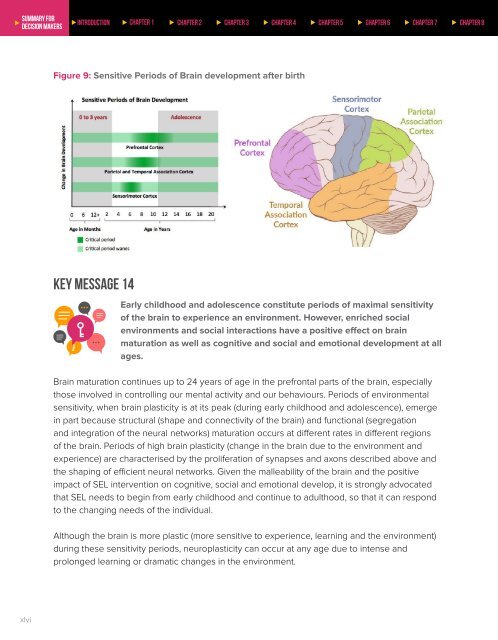Rethinking Learning: Summary for Decision Makers
This publication reviews the latest research on Social and Emotional Learning (SEL), its impact on student health and school climate and its transformative role in building happier classrooms. It seeks to inform and impress upon Member States the urgent need to mainstream social and emotional learning in education systems.
This publication reviews the latest research on Social and Emotional Learning (SEL), its impact on student health and school climate and its transformative role in building happier classrooms. It seeks to inform and impress upon Member States the urgent need to mainstream social and emotional learning in education systems.
Create successful ePaper yourself
Turn your PDF publications into a flip-book with our unique Google optimized e-Paper software.
<strong>Summary</strong> <strong>for</strong><br />
<strong>Decision</strong> <strong>Makers</strong><br />
Introduction Chapter 1 Chapter 2 Chapter 3 Chapter 4 Chapter 5 Chapter 6 Chapter 7 Chapter 8<br />
Figure 9: Sensitive Periods of Brain development after birth<br />
Key Message 14<br />
Early childhood and adolescence constitute periods of maximal sensitivity<br />
of the brain to experience an environment. However, enriched social<br />
environments and social interactions have a positive effect on brain<br />
maturation as well as cognitive and social and emotional development at all<br />
ages.<br />
Brain maturation continues up to 24 years of age in the prefrontal parts of the brain, especially<br />
those involved in controlling our mental activity and our behaviours. Periods of environmental<br />
sensitivity, when brain plasticity is at its peak (during early childhood and adolescence), emerge<br />
in part because structural (shape and connectivity of the brain) and functional (segregation<br />
and integration of the neural networks) maturation occurs at different rates in different regions<br />
of the brain. Periods of high brain plasticity (change in the brain due to the environment and<br />
experience) are characterised by the proliferation of synapses and axons described above and<br />
the shaping of efficient neural networks. Given the malleability of the brain and the positive<br />
impact of SEL intervention on cognitive, social and emotional develop, it is strongly advocated<br />
that SEL needs to begin from early childhood and continue to adulthood, so that it can respond<br />
to the changing needs of the individual.<br />
Although the brain is more plastic (more sensitive to experience, learning and the environment)<br />
during these sensitivity periods, neuroplasticity can occur at any age due to intense and<br />
prolonged learning or dramatic changes in the environment.<br />
xlvi


















